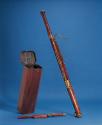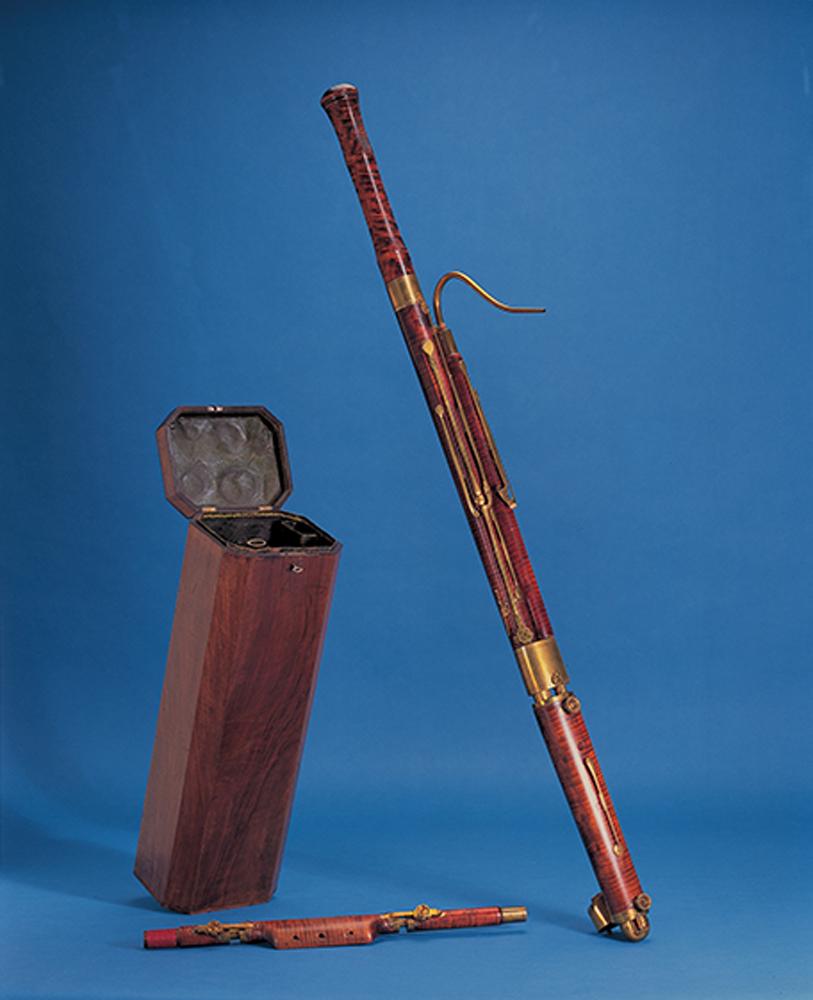Home
>
Works
>
Bassoon, C
>
Advanced Search
Woodwinds
Bassoons
Bassoon, C
Maker: Jean Nicolas Savary jeune
Date: 1823
Place Made:Paris, France, Europe
Serial No: none
SignedStamped on bell and extra wing joint: [sun] / Savary / Jeune / A PARIS / [sun]
Stamped on long joint: [sun] / Savary / A PARIS / [sun]
Stamped on wing joint: [sun] / Savary / Jeune / A PARIS / [sun] / 2
Stamped on butt joint: [sun] / Savary / Jeune / A PARIS
Stamped on long joint: [sun] / Savary / A PARIS / [sun]
Stamped on wing joint: [sun] / Savary / Jeune / A PARIS / [sun] / 2
Stamped on butt joint: [sun] / Savary / Jeune / A PARIS
MarkingsStamped on butt joint, just below tuning mechanism screw: 1823 / [bursting sun] / I
DescriptionFlamed maple in 4 sections: wing, butt, long, and bell joints. The instrument has an extra wing joint. Brass ferrules, tuning mechanisms, and keywork. 11 keys with flat, tulip-bulb-shaped covers, mounted in saddles. Flat key springs attached to the body and/or keys. This instrument features 5 mechanically-operated tuning slides fitted on one of the wing joints (2 slides), butt joint (2 slides), and long joint. Brass bocal. Original octagonal, wooden (mahogany) case fitted for the 5 joints and bocal.
Jean Nicolas Savary (1786-1853) was a French bassoon maker and bassoonist. He probably started making bassoons in 1816-1817, in association with his father, Savary "père" (ca. 1798 - ca. 1827). By 1823, he had his own workshop, styling himself Savary "jeune," and was listed as "fournisseur de la maison du Roi, de l’Académie et de l’école royale." In that same year, he invented a perfected bassoon model with a "branche à coulisse mécanique" (joint with mechanical tuning-slide) and a "culasse à bascule" (butt bascule-mechanism), of which NMM 2418 is representative.
Although a number of Savary bassoons survive in various worldwide collections, this appears to be the only surviving example of this unique model, which is otherwise known only by advertisements placed in trade journals in 1823 (the same date that is stamped on the instrument). This may well have been a prototype, the only example that Savary built. All of the various tuning slides would allow for a closer intonation when extending length, since little bits are added in several places and maintaining a better relationship to the toneholes. It may have helped minimize the lack of ability to change the length between the toneholes.
Many of Savary jeune's instruments were fitted with pioneer mechanisms, such as a form of automatic crook-key mechanism and key rollers. His instruments, which he habitually dated with stamps, were unequalled for the sweetness and singing quality of their tone, and remained in use and sought after by professionals well into the 20th century, particularly in England. Although the French "diapason normal" brought the Savary era to an end in France only six years after he died, the higher pitch used in English orchestras and bands lasted until 1927. Captain Charles Russell Day, who compiled the "Descriptive Catalogue of the Musical Instruments exhibited at the Royal Military Exhibition" in London, 1890, called him "the Stradivari of the bassoon."
Jean Nicolas Savary (1786-1853) was a French bassoon maker and bassoonist. He probably started making bassoons in 1816-1817, in association with his father, Savary "père" (ca. 1798 - ca. 1827). By 1823, he had his own workshop, styling himself Savary "jeune," and was listed as "fournisseur de la maison du Roi, de l’Académie et de l’école royale." In that same year, he invented a perfected bassoon model with a "branche à coulisse mécanique" (joint with mechanical tuning-slide) and a "culasse à bascule" (butt bascule-mechanism), of which NMM 2418 is representative.
Although a number of Savary bassoons survive in various worldwide collections, this appears to be the only surviving example of this unique model, which is otherwise known only by advertisements placed in trade journals in 1823 (the same date that is stamped on the instrument). This may well have been a prototype, the only example that Savary built. All of the various tuning slides would allow for a closer intonation when extending length, since little bits are added in several places and maintaining a better relationship to the toneholes. It may have helped minimize the lack of ability to change the length between the toneholes.
Many of Savary jeune's instruments were fitted with pioneer mechanisms, such as a form of automatic crook-key mechanism and key rollers. His instruments, which he habitually dated with stamps, were unequalled for the sweetness and singing quality of their tone, and remained in use and sought after by professionals well into the 20th century, particularly in England. Although the French "diapason normal" brought the Savary era to an end in France only six years after he died, the higher pitch used in English orchestras and bands lasted until 1927. Captain Charles Russell Day, who compiled the "Descriptive Catalogue of the Musical Instruments exhibited at the Royal Military Exhibition" in London, 1890, called him "the Stradivari of the bassoon."
DimensionsOverall length: 1252 mm
Wing joint: 420 mm
Butt joint: 423 mm
Long joint: 499 mm
Bell joint: 330 mm
(excluding tenons)
Wing joint: 420 mm
Butt joint: 423 mm
Long joint: 499 mm
Bell joint: 330 mm
(excluding tenons)
ProvenancePreviously owned by the De Cicogna family, Milan, Italy. In summer 1976, David Murdock, of John and Arthur Beare, brought it to London. Between 1976 and 1978, presumably sold by Beare to Wurlitzer-Bruck, New York, from whom the NMM purchased it, May 1978.
Terms
Credit Line: Ringley Fund, 1978
On view
Published ReferencesKopp, James. "The English Taste for Savary Bassoons." _The Double Reed_ 35, no. 3 (2012): 95-107.
Larson, André P. _Beethoven: Musical Treasures from The Age of Revolution and Romance_, with essays by John Eliot Gardner, William Meredith, and Gerhard Stradner. Exhibition catalog, Bowers Museum of Cultural Art, Santa Ana, California, January 30-March 21, 1999. Santa Ana: The Bowers Museum, 1999. (p. 13)
Larson, André P. _Beethoven & Berlioz, Paris & Vienna: Musical Treasures from the Age of Revolution & Romance 1789-1848_, with essay by John Koster. Exhibition catalog, Washington Pavilion, Sioux Falls, South Dakota, September 12-November 2, 2003. Vermillion: National Music Museum 2003. (p. 50)
Young, Phillip T. _4,900 Historical Woodwind Instruments_. London: Tony Bingham, 1993. (p. 199)
Waterhouse, William. "Savary, Jean Nicholas." _The New Langwill Index_. London: Tony Bingham, 1993. (p. 347)
Waterhouse, William. "Savary, Jean Nicolas." Grove Music Online. 2001; Accessed 1 Jun. 2020. https://www-oxfordmusiconline-com.ezproxy.usd.edu/grovemusic/view/10.1093/gmo/9781561592630.001.0001/omo-9781561592630-e-0000024650.
Larson, André P. _Beethoven: Musical Treasures from The Age of Revolution and Romance_, with essays by John Eliot Gardner, William Meredith, and Gerhard Stradner. Exhibition catalog, Bowers Museum of Cultural Art, Santa Ana, California, January 30-March 21, 1999. Santa Ana: The Bowers Museum, 1999. (p. 13)
Larson, André P. _Beethoven & Berlioz, Paris & Vienna: Musical Treasures from the Age of Revolution & Romance 1789-1848_, with essay by John Koster. Exhibition catalog, Washington Pavilion, Sioux Falls, South Dakota, September 12-November 2, 2003. Vermillion: National Music Museum 2003. (p. 50)
Young, Phillip T. _4,900 Historical Woodwind Instruments_. London: Tony Bingham, 1993. (p. 199)
Waterhouse, William. "Savary, Jean Nicholas." _The New Langwill Index_. London: Tony Bingham, 1993. (p. 347)
Waterhouse, William. "Savary, Jean Nicolas." Grove Music Online. 2001; Accessed 1 Jun. 2020. https://www-oxfordmusiconline-com.ezproxy.usd.edu/grovemusic/view/10.1093/gmo/9781561592630.001.0001/omo-9781561592630-e-0000024650.
Object number: 02418















